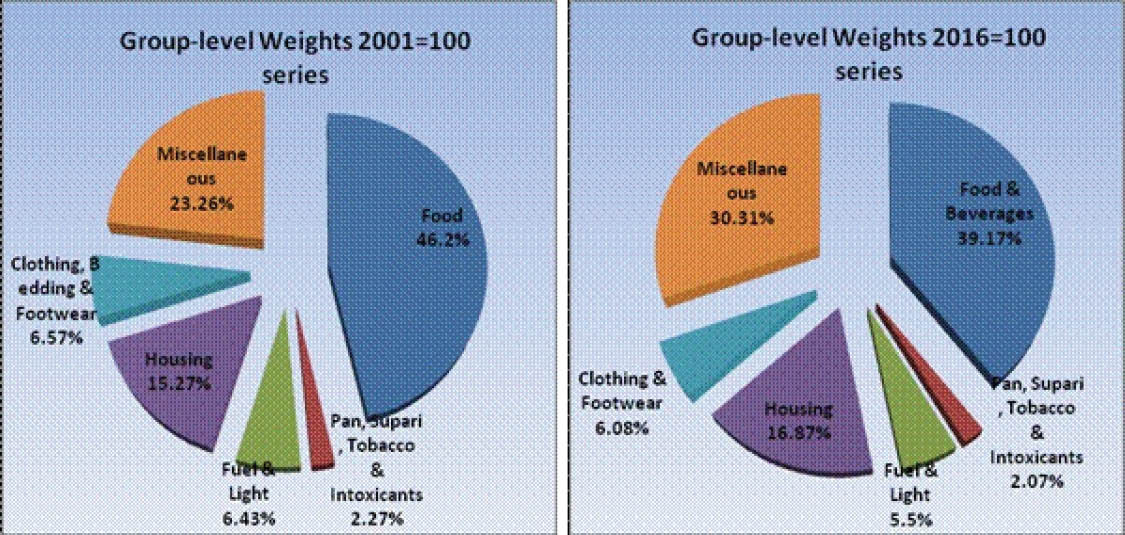Indian Economy
CPI-IW Base Year Revised to 2016
- 23 Oct 2020
- 6 min read
Why in News
Recently, the Ministry of Labour and Employment released the new series of Consumer Price Index for Industrial Worker (CPI-IW) with base year 2016.
- The new series of CPI-IW with base 2016 has replaced the existing series with base 2001.
- Earlier, the series were also revised from 1944 to 1949; 1949 to 1960; 1960 to 1982 and 1982 to 2001.
CPI-IW
- The CPI-IW is mainly used for determining dearness allowance (DA) paid to central/state government employees and workers in the industrial sectors besides measuring inflation in retail prices, fixation and revision of minimum wages in scheduled employments.
- CPI-IW is compiled and maintained by the Labour Bureau, an attached office of the Ministry of Labour & Employment.
Key Points
- New Series:
- The new series with base year 2016 covers the latest consumption pattern of the target population.
- It gives more weightage to spending on health, education, recreation and other miscellaneous expenses, while reducing the weight of food and beverages.
- The weight of spending on housing and clothing increased from 15.2% to 17%.
- The weight of miscellaneous items, like education and health rose to 30.31% from 23.26%.
- The weight of food and beverage was reduced from 46.2% to 39% and indicates an increase in disposable income.
- The number of markets and the sample size for working class family income and expenditure surveys were increased.
- The sample size was increased from 41,040 families to 48,384, also the number of selected markets for collecting retail price data was increased from 289 to 317.
- The number of items in the index basket has increased to 463 items as against 392 items in the 2001 series.
- The Labour Bureau is also working towards revising the index every five years.
- Effect:
- The new series would not have an immediate impact on the dearness allowance (DA) as the government has freezed biannual hike in dearness allowances since January 2020 to offset the financial implications on the exchequer during the coronavirus pandemic.
- The DA, a component of salary, is revised every six months to keep pace with the inflation rate.
- For private sector workers, the central government and most states increase the variable DA component of minimum wages twice a year based on the CPI-IW inflation numbers.
- However, the change in base year will certainly have an effect on DA calculation by june 2021, when the freezing on DA will come to end.
- The new series would not have an immediate impact on the dearness allowance (DA) as the government has freezed biannual hike in dearness allowances since January 2020 to offset the financial implications on the exchequer during the coronavirus pandemic.
Consumer Price Index
- It measures price changes from the perspective of a retail buyer. It is released by the National Statistical Office (NSO).
- The CPI calculates the difference in the price of commodities and services such as food, medical care, education, electronics etc, which Indian consumers buy for use.
- The CPI has several sub-groups including food and beverages, fuel and light, housing and clothing, bedding and footwear.
- At present, India has five consumer price indexes (CPIs), three of which are working-class specific. These are:
- CPI for Industrial Workers (IW).
- CPI for Agricultural Labourer (AL).
- CPI for Rural Labourer (RL).
- These three indexes are compiled by the Labour Bureau in the Ministry of Labour and Employment.
- CPIs AL and RL are used to fix minimum wages of agricultural labourers and rural unskilled employees.
- The Labour Bureau is also expected to bring out the new series of the CPI- AL/RL, which currently has the base year of 1986-87 by August 2021.
- The other two are CPI-Urban and CPI Rural. These two indexes are compiled by the National Statistical Office (NSO) in the Ministry of Statistics and Programme Implementation.
- The combined rise in retail prices is captured by CPI Combined.
- A committee set up by the National Statistical Commission (NSC) in 2005 under the recommendation of Dr C Rangarajan Commission, has suggested that CPI-Rural and CPI-Urban could be a substitute for CPI-AL/RL and CPI-IW, respectively.
Way Forward
- The new series will serve as a useful reference book for researchers, academicians, scholars and all other stakeholders of CPI-IW.
- The improvements made in the new series will make it more comparable at international level. It will help in measurements of macroeconomic indicators of the Indian economy.
- As per the recommendations of International Labour Organisation (ILO), Index Review Committee (IRC) and National Statistical Commission (NSC) the base year of price index numbers should be revised at frequent intervals generally not exceeding 10 years to reflect the changes that take place in the consumption pattern of consumers.





